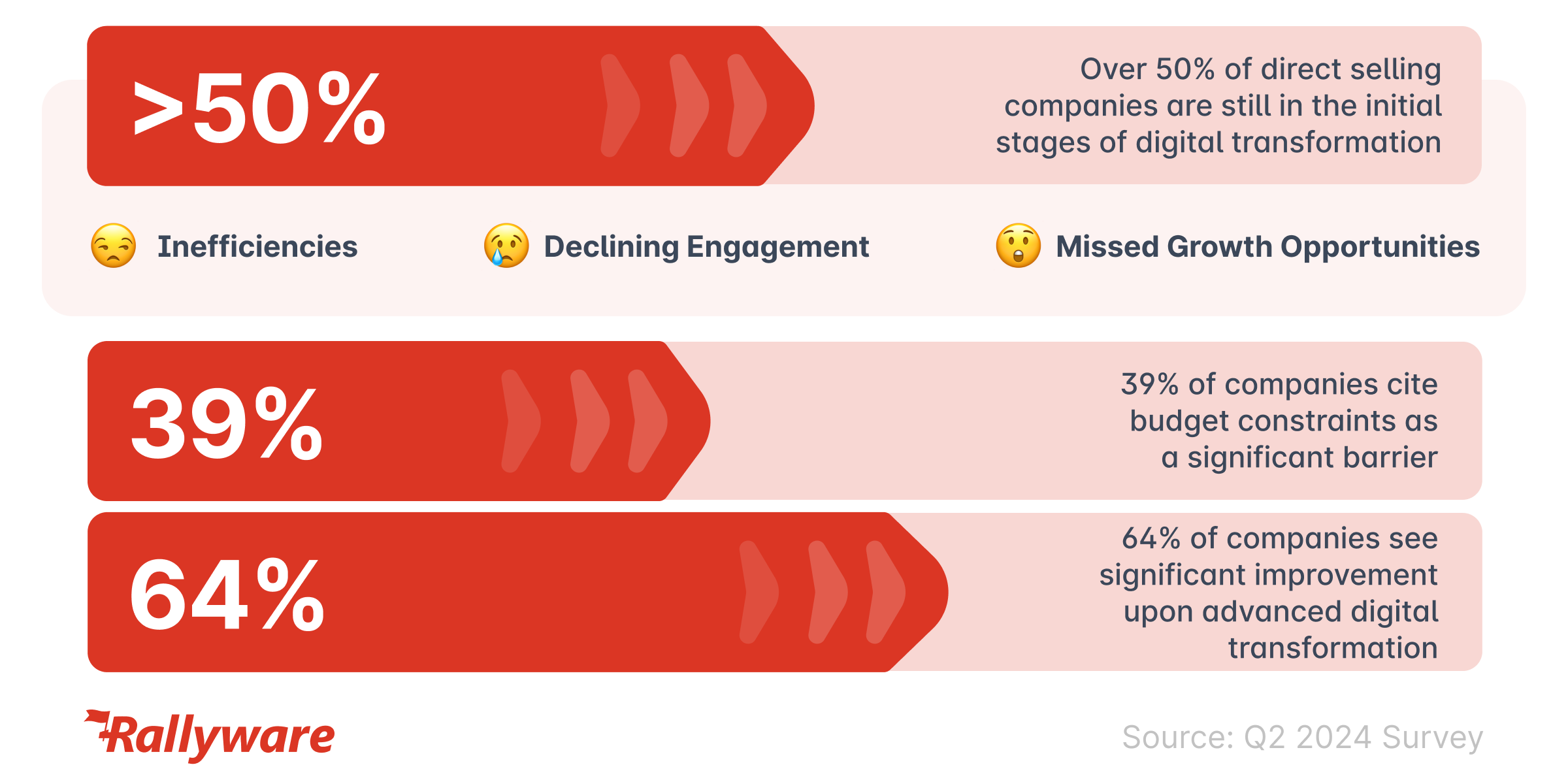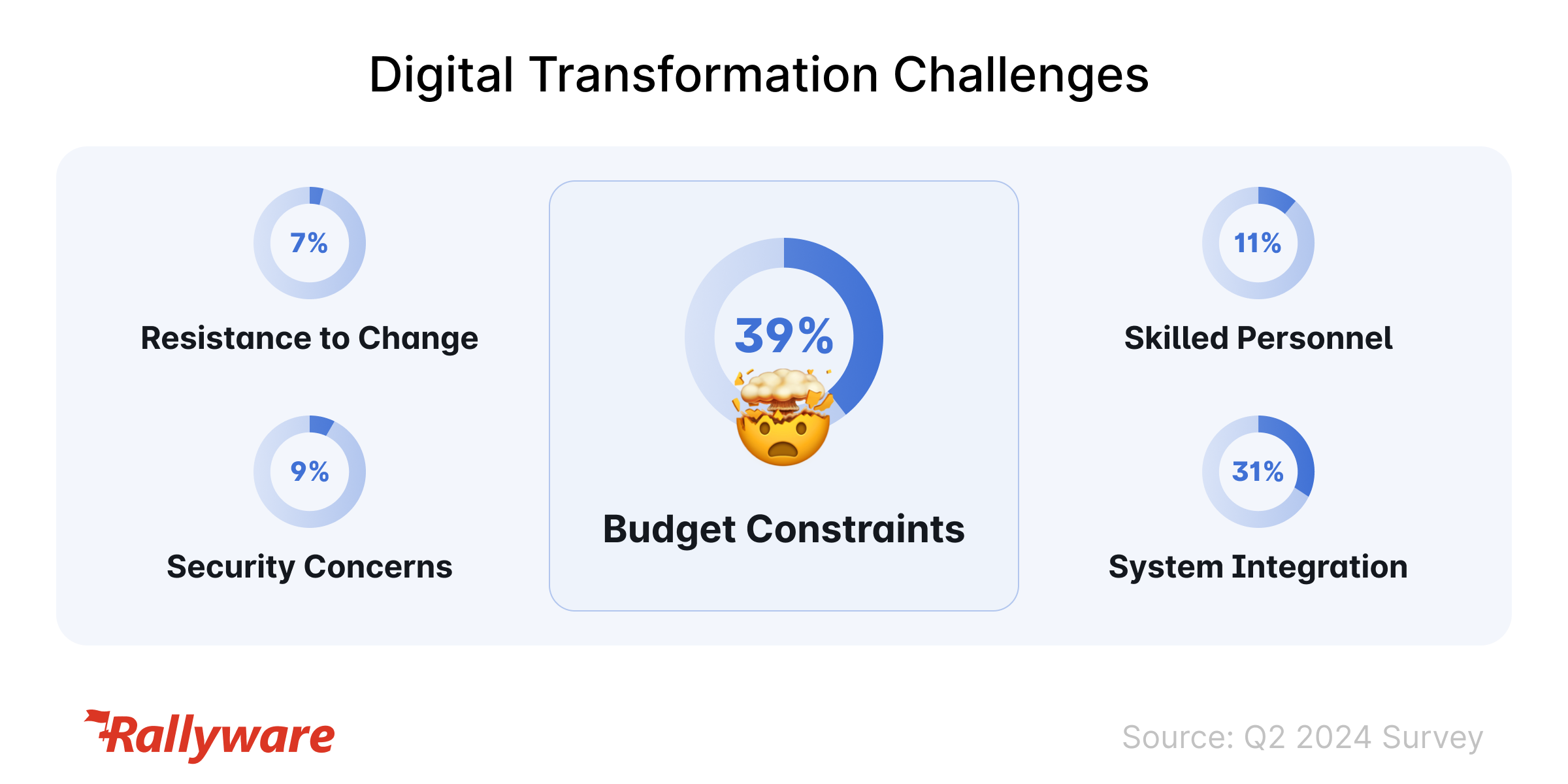Workforce Training and Development: The Value of Relevant Content
The Digital Divide: Over 50% of Direct Sellers Falling Behind in Transformation
Over 50% of direct selling companies are still in the initial stages of digital transformation. This startling finding from the recent Q2 2024 Survey highlights a critical issue facing the industry. In a world where digital transformation is no longer a luxury but a necessity, these companies risk falling behind, struggling with inefficiencies, declining engagement, and missed growth opportunities.
39% of these companies cite budget constraints as a significant barrier. This is not just a matter of finance but a strategic oversight. As direct sellers continue to rely on traditional methods, the gap widens between those embracing digital change and those lagging behind with non-scalable strategies that don’t allow them to act quickly, responding to market changes and distributor needs.
64% of companies measuring live distributor sales performance report significant improvements. This data underscores the tangible benefits of digital transformation, from enhanced distributor engagement to streamlined sales enablement processes.

With these insights in mind, it’s crucial to understand why advancing digital transformation is essential for the survival and success of direct selling companies.
Key Benefits of Advanced Digital Transformation
Enhanced Distributor Experience
One of the primary benefits of advanced digital transformation is the enhanced distributor experience. Digital platforms and AI tools can revolutionize how distributors interact with the company and their customers.
For instance, AI-powered enablement and training programs can personalize learning experiences, ensuring distributors receive relevant and timely information. This leads to better upskilling and more engagement in business-building activities. Distributors equipped with smart tools can access real-time data on customer preferences, receive automated product recommendations, and follow up with personalized messages. These capabilities not only improve the distributor’s efficiency but also enhance customer loyalty.
Driving Desired Distributor Behaviors at Scale
Automation tools streamline sales processes, making it easier for distributors to manage their activities. Smart tools can suggest which customers to reach out to, what messages to send, and which products to recommend. This level of personalization and automation drives desired behaviors, such as regular follow-ups and tailored customer interactions.
Consider a day in the life of a distributor using these tools. In the morning, they receive a notification about customers who haven’t purchased in a while. The system suggests sending a personalized offer. Later, the distributor receives insights on customers’ buying patterns and preferences, allowing them to recommend complementary products. By the end of the day, the distributor has not only reached out to lapsed customers but also increased their sales through targeted recommendations. This seamless process is made possible by advanced digital tools, significantly boosting sales performance.
Improved Data Analytics
Data analytics plays a crucial role in digital transformation. Companies leveraging data can make informed decisions and develop effective strategies. Advanced analytics provides a 360-degree view of operations, enabling companies to track performance, identify trends, and make data-driven decisions.
Leading direct selling companies use data analytics to monitor distributor performance in real time. By analyzing sales data, they identify top-performing distributors and replicate their strategies across the network with targeted campaigns. Additionally, data analytics helps in assessing the effectiveness of enablement tools, training programs, and marketing campaigns, ensuring resources are allocated to initiatives that drive the most significant impact.
Overcoming Challenges
Top 5 Challenges Identified
The Q2 2024 Survey identifies several challenges that companies face in their digital transformation journey:
- Budget Constraints (39%): Limited budgets can hinder the adoption of advanced technologies. Companies must prioritize investments and seek cost-effective solutions.
- System Integration (31%): Integrating new digital tools with existing systems can be complex. Companies need robust strategies to ensure seamless integration.
- Skilled Personnel (11%): A shortage of skilled personnel can slow down digital initiatives. Investing in training and development is crucial to building a capable workforce.
- Security Concerns (9%): As companies adopt digital tools, ensuring data security becomes paramount. Implementing robust security measures is essential to protect sensitive information.
- Resistance to Change (7%): Change can be challenging, especially in traditional industries. Companies must foster a culture that embraces innovation and change.

Actionable Solutions
To overcome these challenges, companies can adopt several strategies:
- Addressing Budget Constraints: Prioritize digital investments that offer the highest ROI. Consider scalable and consolidated solutions that can grow with the company’s needs while replacing various tools in one.
- System Integration: Develop a comprehensive integration plan that includes testing and validation. Partnering with experienced technology providers can also ease the integration process.
- Managing Skilled Personnel: Invest in training and development programs to build a skilled workforce. Encourage continuous learning and provide opportunities for employees to upskill.
- Ensuring Security: Implement robust security protocols and regularly update them to address emerging threats. Conduct regular security audits to identify and mitigate vulnerabilities.
- Overcoming Resistance to Change: Communicate the benefits of digital transformation clearly to all stakeholders. Involve employees in the decision-making process and provide support during the transition.
Leadership in Driving a Change
Role of Cross-Functional Teams
Leadership plays a critical role in driving digital transformation. The survey reveals that over 50% of companies recommend cross-functional leadership, involving multiple departments in the transformation process. This approach ensures that digital initiatives align with overall business objectives and receive support from various stakeholders.
Key Roles in Leading Digital Transformation
Several key roles are essential for leading digital transformation:
- CTO (Chief Technology Officer): The CTO oversees the adoption of new technologies and ensures they align with the company’s strategic goals.
- CIO (Chief Information Officer): The CIO manages the company’s IT infrastructure and ensures seamless integration of digital tools.
- Digital Transformation Officers: These officers are dedicated to driving digital initiatives and ensuring they deliver value.
Creating a Culture of Innovation
Fostering a culture of innovation is crucial for successful digital transformation. Companies must encourage experimentation, reward innovation, and provide resources for employees to explore new ideas. This culture of innovation can drive continuous improvement and ensure the company remains competitive. Here’s what some of the direct selling leaders have to says about preparing for 2025.
To thrive in 2025, direct selling companies must harness digital tools for growth and scalability. Fragmented tech platforms waste opportunities and drag down distributor efficiency. I’ve seen firsthand how a strategic digital transformation can turn things around.
George Elfond, Rallyware CEO
The Q2 2024 Survey highlights a significant digital divide in the direct selling industry, with over 50% of companies still in the initial stages of digital transformation. Advancing in this journey is crucial for companies to remain competitive, enhance distributor engagement, and drive growth.
Ready to transform your business? Request a demo with Rallyware today and speak with our experts who have extensive experience assisting leading direct selling companies on their digital transformation journey.
News and Insights on Workforce Training & Engagement
We’re among top-notch eLearning and business engagement platforms recognized for effective training and talent development, helping to empower distributed workforces
Subscribe
